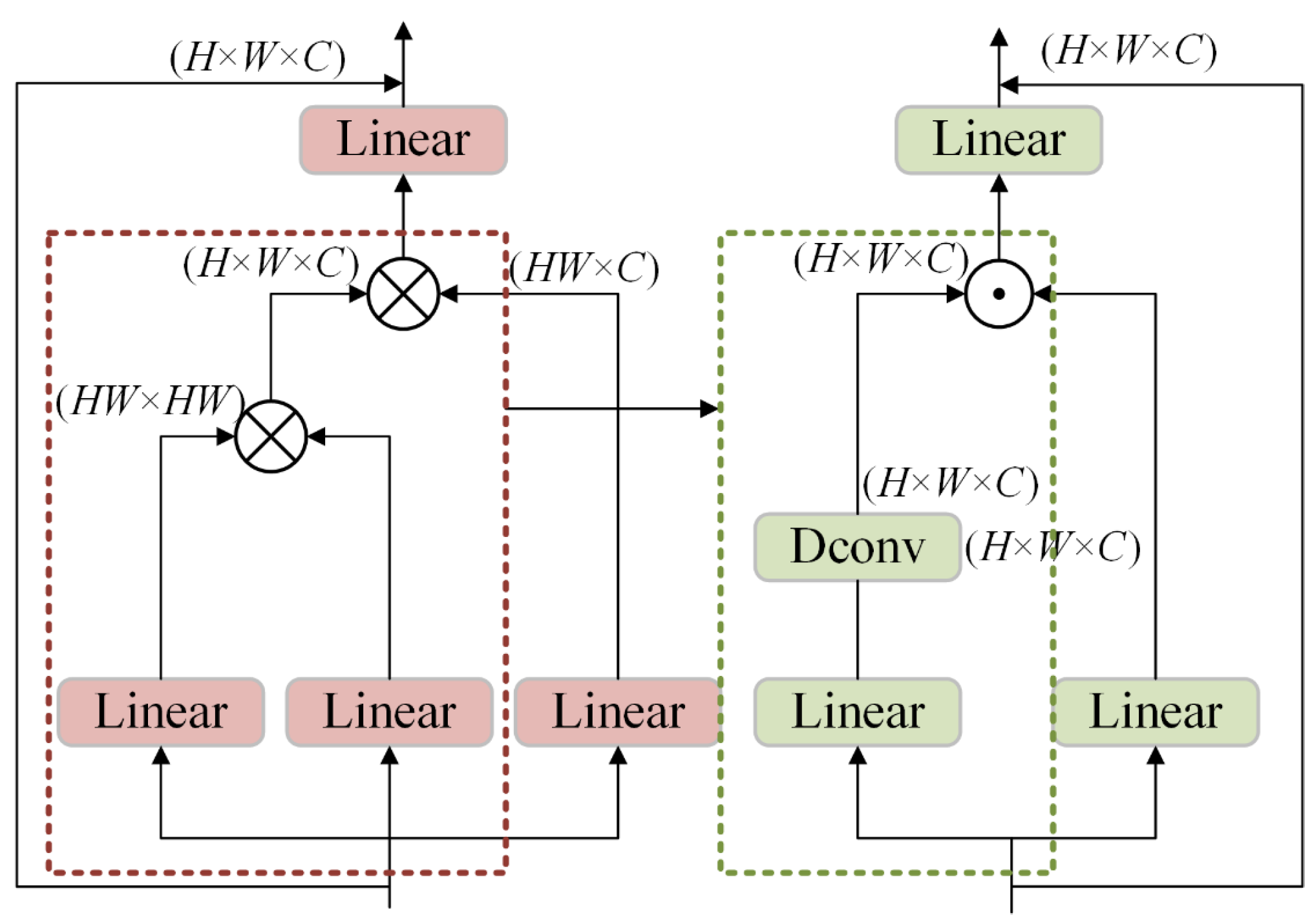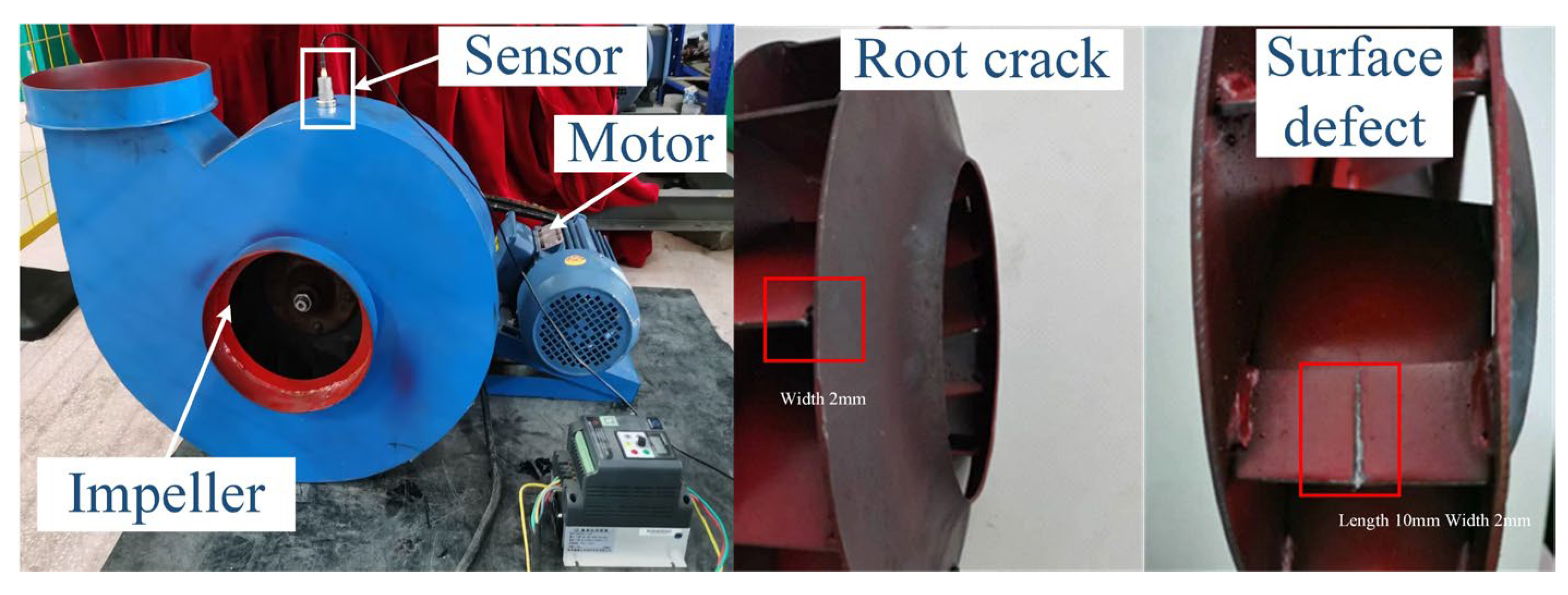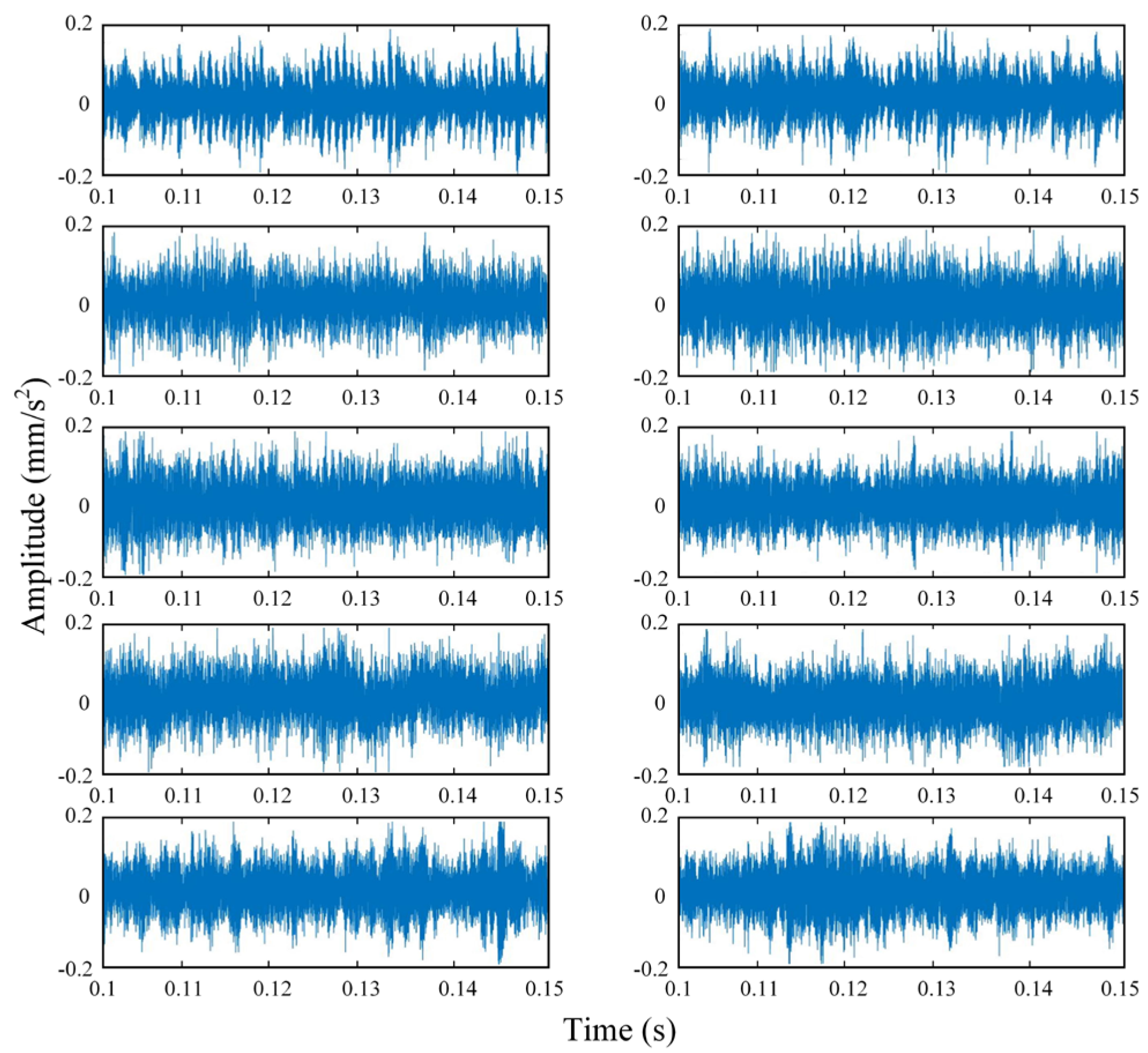Simulated Centrifugal Fan Blade Fault Diagnosis Based on Modulational Depthwise Convolution–One-Dimensional Convolution Neural Network (MDC-1DCNN) Model
Abstract
:1. Introduction
- A new convolutional neural network structure called a convolutional modulation module (CMM) is constructed. The CMM combines powerful local sensing capability and global modeling capability and is able to capture signal features more comprehensively.
- A fault diagnosis model called MDC-1DCNN is proposed. Multiple depthwise convolution (DWconv) convolutional layers of different sizes are introduced into Conv2Former to capture both high- and low-frequency information in the signal. In addition, embedding an 11 × 1 DWconv in the multilayer perceptron not only saves computational resources significantly but also enhances the representation of spatial information.
- Simulation and real datasets are constructed. We simulate and analyze the actual working state of centrifugal fan blades and construct a simulation dataset. At the same time, a rotating impeller experimental bench is built to obtain a dataset under real working conditions.
2. Methodology
2.1. Details of DWconv
2.2. Details of the CMM
2.3. Details of the MDC-1DCNN
3. Experimental Setting
3.1. Details of Experiment
3.2. Details of Simulation Experiment
3.3. Data Preparation
4. Experimental Results and Discussion
4.1. Diagnostic Performance of the Proposed Method
4.2. Comparison Experiments with Other Methods
4.3. Ablation Study
5. Conclusions
Author Contributions
Funding
Data Availability Statement
Conflicts of Interest
References
- Zhou, S.Q.; Yang, K.; Zhang, W.T.; Zhang, K.; Wang, C.H.; Jin, W.Y. Optimization of multi-blade centrifugal fan blade design for ventilation and air-conditioning system based on disturbance CST function. Appl. Sci. 2021, 11, 7784. [Google Scholar] [CrossRef]
- Meng, F.N.; Wang, L.J.; Ming, W.Y.; Zhang, H.X. Aerodynamics optimization of multi-blade centrifugal fan based on extreme learning machine surrogate model and particle swarm optimization algorithm. Metals 2023, 13, 1222. [Google Scholar] [CrossRef]
- Zhang, T.; Xu, F.Y.; Jia, M.P. A centrifugal fan blade damage identification method based on the multi-level fusion of vibro-acoustic signals and CNN. Measurement 2022, 199, 111475. [Google Scholar] [CrossRef]
- Bandyopadhyay, I.; Purkait, P.; Koley, C. Performance of a classifier based on time-domain features for incipient fault detection in inverter drives. IEEE Trans. Ind. Inform. 2018, 15, 3–14. [Google Scholar] [CrossRef]
- Xu, Z.; Cao, D.; Zhou, Y.; Gao, J. Application of neural network algorithm in fault diagnosis of mechanical intelligence. Mech. Syst. Signal Process. 2020, 141, 106625. [Google Scholar] [CrossRef]
- Rao, A.R.; Dutta, B.K. Vibration analysis for detecting failure of compressor blade. Eng. Fail. Anal. 2012, 25, 211–218. [Google Scholar]
- Gubran, A.A.; Sinha, J.K. Shaft instantaneous angular speed for blade vibration in rotating machine. Mech. Syst. Signal Process. 2014, 44, 47–59. [Google Scholar] [CrossRef]
- Wang, Z.Y.; Yao, L.G.; Cai, Y.W. Rolling bearing fault diagnosis using generalized refined composite multiscale sample entropy and optimized support vector machine. Measurement 2020, 156, 107574. [Google Scholar] [CrossRef]
- Sayanjit, S.R.; Sayantan, D.; Soumya, C. Autocorrelation aided random forest classifier-based bearing fault detection framework. IEEE Sens. J. 2020, 20, 10792–10800. [Google Scholar]
- Qian, X.Y.; Sun, T.H.; Wang, B.S.; Zhang, Y.X. A weighted KNN fault detection based on multistep index and dynamic neighborhood scale under complex working conditions. IEEE Access 2023, 11, 49183–49192. [Google Scholar] [CrossRef]
- Su, J.L.; Wang, H.J.; Wang, Z.B.; Liu, S.C.; Wang, N.; Zhang, S.L. Multi-channel convolutional neural network and migration learning for gas turbine rotor fault diagnosis. J. Electron. Meas. Instrum. 2023, 37, 132–140. [Google Scholar]
- Dao, F.; Zeng, Y.; Qian, J. Fault diagnosis of hydro-turbine via the incorporation of bayesian algorithm optimized CNN-LSTM neural network. Energy 2024, 290, 130326. [Google Scholar] [CrossRef]
- Zhang, D.; Chen, Y.Y.; Guo, F.H.; Karimi, H.R.; Dong, H.; Xuan, Q. A new interpretable learning method for fault diagnosis of rolling bearings. IEEE Trans. Instrum. Meas. 2021, 70, 3507010. [Google Scholar] [CrossRef]
- Tang, S.N.; Zhu, Y.; Yuan, S.Q. An improved convolutional neural network with an adaptable learning rate towards multi-signal fault diagnosis of hydraulic piston pump. Adv. Eng. Inform. 2021, 50, 101406. [Google Scholar] [CrossRef]
- Zhang, k.; Wang, J.Y.; Shi, H.T.; Zhang, X.C.; Tang, Y.H. A fault diagnosis method based on improved convolutional neural network for bearings under variable working conditions. Measurement 2021, 182, 109749. [Google Scholar] [CrossRef]
- Shao, S.Y.; Yan, R.Q.; Lu, Y.D.; Wang, P.; Gao, R.X. DCNN-based multi-signal induction motor fault diagnosis. IEEE Trans. Instrum. Meas. 2020, 69, 2658–2669. [Google Scholar] [CrossRef]
- Xie, T.L.; Huang, X.F.; Choi, S.K. Intelligent mechanical fault diagnosis using multisensor fusion and convolution neural network. IEEE Trans. Ind. Inform. 2022, 18, 3213–3223. [Google Scholar] [CrossRef]
- Zhou, X.; Zhang, Y.C.; Liu, Z.; Jiang, Z.Y.; Ren, Z.H.; Mi, T.C.; Zhou, S.H. IFIFusion: A independent feature information fusion model for surface defect detection. Inf. Fusion 2025, 120, 103039. [Google Scholar] [CrossRef]
- Zhang, Y.C.; Ding, J.L.; Li, Y.B.; Ren, Z.H.; Feng, K. Multi-modal data cross-domain fusion network for gearbox fault diagnosis under variable operating conditions. Eng. Appl. Artif. Intell. 2024, 133, 108236. [Google Scholar] [CrossRef]
- Chen, S.M.; Yu, J.B.; Wang, S.J. One-dimensional convolutional neural network-based active feature extraction for fault detection and diagnosis of industrial processes and its understanding via visualization. ISA Trans. 2022, 122, 424–443. [Google Scholar] [CrossRef]
- Yu, J.B.; Zhou, X.K. One-dimensional residual convolutional autoencoder based feature learning for gearbox fault diagnosis. IEEE Trans. Ind. Inform. 2020, 16, 6347–6358. [Google Scholar] [CrossRef]
- Zhang, Y.C.; Ren, Z.H.; Zhou, S.H.; Feng, K.; Yu, K.; Liu, Z. Supervised contrastive learning-based domain adaptation network for intelligent unsupervised fault diagnosis of rolling bearing. IEEE ASME Trans. Mechatron. 2022, 27, 5371–5380. [Google Scholar] [CrossRef]
- Wang, H.; Liu, Z.L.; Peng, D.D.; Qin, Y. Understanding and learning discriminant features based on multi attention 1DCNN for wheelset bearing fault diagnosis. IEEE Trans. Ind. Inform. 2020, 16, 5735–5745. [Google Scholar] [CrossRef]
- Dong, Z.L.; Zhao, D.Z.; Cui, L.L. An intelligent bearing fault diagnosis framework: One-dimensional improved self-attention-enhanced CNN and empirical wavelet transform. Nonlinear Dyn. 2024, 112, 6439–6459. [Google Scholar] [CrossRef]
- Chen, Z.X.; Yu, W.N.; Wang, L.M.; Ding, X.X.; Huang, W.B.; Shao, Y. M A Dual-View Style Mixing Network for unsupervised cross-domain fault diagnosis with imbalanced data. Knowl. Based Syst. 2024, 278, 110918. [Google Scholar] [CrossRef]
- Peng, Y.; Liu, D.T. An overview of data-driven fault prediction and health management. Chin. J. Sci. Instrum. 2014, 35, 481–495. [Google Scholar]
- Zhang, Y.C.; Zhou, X.; Gao, C.; Lin, J.D.; Ren, Z.H.; Feng, K. Contrastive learning-enabled digital twin framework for fault diagnosis of rolling bearing. Meas. Sci. Technol. 2024, 36, 015026. [Google Scholar] [CrossRef]
- Tao, H.F.; Cheng, L.; Qiu, J.E.; Stojanovic, V. Few shot cross equipment fault diagnosis method based on parameter optimization and feature mertic. Meas. Sci. Technol. 2022, 33, 115005. [Google Scholar] [CrossRef]
- Fan, C.Z.; Wang, P.F.; Zhang, Y.C.; Ma, H.; Li, X.; Wang, Q.B. Digital twin assisted degradation assessment of bearing cage performance. IEEE Trans. Ind. Inform. 2025, 1–11. [Google Scholar] [CrossRef]
- Yin, H.; Wang, Y.F.; Sun, W.S.; Wang, L.T. Fault diagnosis of hydraulic system based on D-S evidence theory and SVM. Int. J. Hydromechatron. 2024, 7, 1–15. [Google Scholar] [CrossRef]
- Hei, Z.D.; Sun, W.F.; Yang, H.Y.; Zhong, M.P.; Li, Y.L.; Kumar, A.; Xiang, J.W.; Zhou, Y.Q. Novel domain-adaptive Wasserstein generative adversarial networks for early bearing fault diagnosis under various conditions. Reliab. Eng. Syst. Saf. 2025, 257, 110847. [Google Scholar] [CrossRef]
- Yu, X.L.; Zhao, Z.B.; Zhang, X.W.; Zhang, Q.Y.; Liu, Y.L.; Sun, C.; Chen, X.F. Deep-learning-based open set fault diagnosis by extreme value theory. IEEE Trans. Ind. Inform. 2022, 18, 185–196. [Google Scholar] [CrossRef]
- Carrattieri, L.; Cravero, C.; Marsano, D.; Valenti, E.; Sishtla, V.; Halbe, C. The development of machine learning models for radial compressor monitoring with instability detection. J. Turbomach. 2025, 147, 051004. [Google Scholar] [CrossRef]
- Hammond, J.; Pepper, N.; Montomoli, F.; Michelassi, V. Machine Learning Methods in CFD for Turbomachinery: A Review. Int. J. Turbomach. Propuls. Power 2022, 7, 16. [Google Scholar] [CrossRef]
- Chollet, F. Xception: Deep learning with depthwise separable convolutions. In Proceedings of the 2017 IEEE Conference on Computer Vision and Pattern Recognition (CVPR), Honolulu, HI, USA, 21–26 July 2017. [Google Scholar]
- Ashish, V.; Noam, S.; Niki, P.; Jakob, U.; Llion, J.; Aidan, N.G.; Łukasz, K.; Illia, P. Attention is all you need. In Proceedings of the Advances in Neural Information Processing Systems 30 (NIPS 2017), Long Beach, CA, USA, 4–9 December 2017. [Google Scholar]
- Chen, B.A. Centrifugal Fan Blade Fault Diagnosis Method and Experimental Research Based on EMD and SVM. Master’s Thesis, Hunan University, Changsha, China, 2019. [Google Scholar]
- Chen, Z.; Jiang, Y.; Zhang, X.Y.; Zheng, R.; Qiu, R.J.; Sun, Y.; Zhao, C.; Shang, H.C. ResNet18DNN: Prediction approach of drug-induced liver injury by deep neural network with ResNet18. Brief. Bioinform. 2022, 23, bbab503. [Google Scholar] [CrossRef] [PubMed]
- Theckedath, D.; Sedamkar, R.R. Detecting affect states using VGG16, ResNet50 and SE-ResNet50 networks. SN Comput. Sci. 2020, 1, 79. [Google Scholar] [CrossRef]
- Geng, D.H.; Wang, B.; Gao, Q. A hybrid photovoltaic/wind power prediction model based on Time2Vec, WDCNN and BiLSTM. Energy Convers. Manag. 2023, 291, 117342. [Google Scholar] [CrossRef]
- Guo, S.; Li, L.; Li, X.; Zhu, J. DFDK-MSNet: A deep fusion framework of domain knowledge and multiscale 1DCNN for specific emitter identification. IEEE Trans. Instrum. Meas. 2025, 74, 9501416. [Google Scholar] [CrossRef]









| Parameter | Value |
|---|---|
| Fan Total Pressure (pa) | 1650 |
| Air Volume (m3/h) | 2322 |
| Fan Speed (r/min) | 2800 |
| Motor Power (kw) | 1.5 |
| Parameter | Value |
|---|---|
| Impeller Diameter (mm) | 390.5 |
| Length (mm) | 110 |
| Width (mm) | 58 |
| Thickness (mm) | 2 |
| Quantity | 16 |
| Label | Fault Type | Training Set | Test Set |
|---|---|---|---|
| 0 | Normal | 2000 | 500 |
| 1 | Tip Crack (1 mm) | ||
| 2 | Tip Crack (2 mm) | ||
| 3 | Tip Crack (3 mm) | ||
| 4 | Root Crack (1 mm) | ||
| 5 | Root Crack (2 mm) | ||
| 6 | Root Crack (3 mm) | ||
| 7 | Surface Defects (1 mm) | ||
| 8 | Surface Defects (2 mm) | ||
| 9 | Surface Defects (3 mm) |
| Label | Fault Type | Training Set | Test Set |
|---|---|---|---|
| 0 | Normal | 800 | 200 |
| 1 | Root Crack | ||
| 2 | Surface Defects |
| Model | Accuracy |
|---|---|
| ResNet18 | 96.15% |
| ResNet50 | 97.47% |
| WDCNN | 86.50% |
| MS-1DCNN | 97.12% |
| MDC-1DCNN | 98.78% |
| Model | Accuracy |
|---|---|
| M0 | 98.78% |
| M1 | 97.50% |
| M2 | 96.89% |
| M3 | 97.43% |
| M4 | 94.63% |
| M5 | 98.33% |
| M1 + M5 | 97.85% |
| M2 + M5 | 97.68% |
| M3 + M5 | 98.18% |
| M4 + M5 | 95.82% |
| M1 + M4 + M5 | 95.62% |
| M2 + M4 + M5 | 95.79% |
| M3 + M4 + M5 | 95.49% |
Disclaimer/Publisher’s Note: The statements, opinions and data contained in all publications are solely those of the individual author(s) and contributor(s) and not of MDPI and/or the editor(s). MDPI and/or the editor(s) disclaim responsibility for any injury to people or property resulting from any ideas, methods, instructions or products referred to in the content. |
© 2025 by the authors. Licensee MDPI, Basel, Switzerland. This article is an open access article distributed under the terms and conditions of the Creative Commons Attribution (CC BY) license (https://creativecommons.org/licenses/by/4.0/).
Share and Cite
Ren, Z.; Liu, Y.; Yu, T.; Zhou, S.; Zhang, Y.; Jiang, Z. Simulated Centrifugal Fan Blade Fault Diagnosis Based on Modulational Depthwise Convolution–One-Dimensional Convolution Neural Network (MDC-1DCNN) Model. Machines 2025, 13, 356. https://doi.org/10.3390/machines13050356
Ren Z, Liu Y, Yu T, Zhou S, Zhang Y, Jiang Z. Simulated Centrifugal Fan Blade Fault Diagnosis Based on Modulational Depthwise Convolution–One-Dimensional Convolution Neural Network (MDC-1DCNN) Model. Machines. 2025; 13(5):356. https://doi.org/10.3390/machines13050356
Chicago/Turabian StyleRen, Zhaohui, Yulin Liu, Tianzhuang Yu, Shihua Zhou, Yongchao Zhang, and Zeyu Jiang. 2025. "Simulated Centrifugal Fan Blade Fault Diagnosis Based on Modulational Depthwise Convolution–One-Dimensional Convolution Neural Network (MDC-1DCNN) Model" Machines 13, no. 5: 356. https://doi.org/10.3390/machines13050356
APA StyleRen, Z., Liu, Y., Yu, T., Zhou, S., Zhang, Y., & Jiang, Z. (2025). Simulated Centrifugal Fan Blade Fault Diagnosis Based on Modulational Depthwise Convolution–One-Dimensional Convolution Neural Network (MDC-1DCNN) Model. Machines, 13(5), 356. https://doi.org/10.3390/machines13050356






